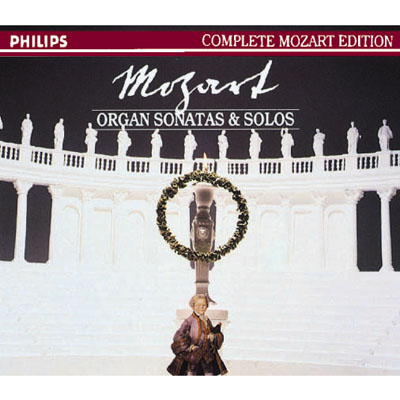|
Philips Mozart
Edition (Mid price) (CD) 422 521-2PME2 (two discs, nas: 115 minutes:
ADD). Played on the Kleine Chor-Orgel (1746), Stift Wilhering, Linz,
Austria. Items marked b played on
the Holzhay-Orgel (1784), Schlosspfarrkirche, Obermarchtal, Germany. From
6747 384 (9/77). |
|
[Sonata]
Sonatas
a —No. 1 in E flat,
K67/41h; No. 2 in B flat, K68/4li; No. 3 in D,
K69/41k; No. 4 in D, K144/124a; No. 5 in F,
K145/124b; No. 6 in B flat, K212; No. 7 in F, K224/241a; No.
8 in A, K225/241b; No. 9 in G, K241; No. 10 in F, K244; No. 11 in
D, K245; No. 12 in C, K263; No. 13 in G, K274; No. 14 in C, K278; No. 15
in C, K328; No. 16 in C, K329; No. 17 in C major, K336. Adagio and Allegro
in F minor, K594
b. Fantasia in F minor,
K608 b. Andante in F, K616. |
|
As Vol. 21 of their
Complete Mozart Edition Philips describe the contents of this two-disc set
as "Organ Sonatas and Solos". Anyone looking for a comprehensive
collection of the fragments, arrangements and uncertain pieces which
represent the sum total of Mozart's organ music, though, will have to look
elsewhere.
The organ solos here
are the three pieces Mozart was commissioned to write for a mechanical
clock installed by the self-styled 'Count' Joseph Deym in the Mausoleum of
Field Marshal Loudon. These pieces were to be played every hour on the
hour and were supposed to be funereal in character—a waxwork of Loudon
reposing in his coffin was the Mausoleum's centre-piece. A strange
commission, indeed, and one which Mozart described in a letter to his wife
as "loathsome work". But while such a mechanically-propelled instrument
would almost certainly have stifled the creative instincts of a lesser
composer, Mozart responded to the challenge with some remarkably fine
music, and only the solemn K608 or the outer sections of K594 can in any
way be described as funereal.
Daniel Chorzempa has
caught the rhythmic regularity of a clock mechanism absolutely perfectly.
The F minor, K594 unfolds with an inevitability which in its own way is
quite captivating, and he carefully avoids excessive use of rubato or
rallentando. The organ makes a lovely bright, clear sound and the
recording is beautifully crisp and alive. It certainly suits the light
character of K594 and 616 splendidly. The more substantial Fantasia
(K608) with its Bach-like fugal sections here lacks some of the splendour
and majesty given to it by Ian Tracey on Mirabilis/Gamut ((CD) MRCD901,
4/91) and in places Chorzempa's fingerwork is not always as clean as it
might be.
The sonatas are, in
fact, the 17 Church Sonatas Mozart wrote to be played between the Epistle
and Gospel during Mass at Salzburg Cathedral. Of necessity these had to be
short pieces, but again Mozart triumphed over a potential adversity and
created some wonderfully brief musical cameos. As for describing them as
organ music, well that might be taking things a little too far. True the
organ plays an integral role in several of them; the final one, for
example, is almost a self-contained concertante movement with the
organ cast in the solo role. But for the most part the organ's function is
little more than a continuo instrument. This is a decidedly grandiose
recording. The large orchestra, hefty organ and opulent acoustic give
these miniatures a pomposity somewhat at odds with their true character.
It must be pointed out, though, that these recordings were made almost 20
years ago, before the use of original instruments and smaller-size
orchestral groups became the accepted norm. The King's Consort on Hyperion
((CD) CDA66377, 11/90) provide a more appropriate version for our age of
authenticity, but those who still hanker after the big sound of a romantic
orchestra playing Mozart will certainly find these performances entirely
acceptable.
MR |
